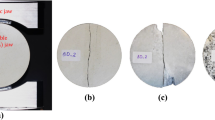Summary
The point load test, developed over the last two decades, provides a practical and cheap method for laboratory or field determination of rock strength. Because of the size dependence of the test, results are corrected to a standard thickness of 50 mm and the resultant I(50) values may be used to estimate uniaxial compressive strength.
Specimen failure is in the tensile mode and size dependence is well accounted for by the Weibull weakest link theory, with the mean point load strength decreasing as specimen thickness increases. When mean point load values are plotted against corresponding specimen sizes, a linear relation with a negative slope is obtained. The slope of the best fit line gives the reciprocal of the Weibull modulus (m). I(50) is then found from the intercept with the 50 mm line.
If rock cores of one size are tested, the m value is estimated first, thus establishing the strength-size relation from which I(50) can be determined.
These methods are simple to apply using mean point load strength values and do not require a correction chart.
The proposed method of plotting the test results enables small rock specimens to be used to determine I(50). The test is applicable to brittle, hard rocks, and this new procedure should increase the practical application of the test.
Résumé
L'essai de poinçonnement utilisé depuis deux décennies, est une méthode pratique et peu coûteuse de détermination en laboratoire ou sur le terrain de la résistance des roches. En raison de l'influence de la taille des éprouvettes, les résultats sont corrigés pour une épaisseur standard de 50 mm et les valeurs I(50) qui en découlent peuvent être utilisées pour estimer la résistance à la compression uniaxiale.
La rupture de l'éprouvette se fait en fraction et l'influence de la taille est bien prise en compte lorsqu'on utilise la théorie de Weibull, dite des liaisons très faibles, la résistance au poinçonnement moyenne diminuant lorsque l'épaisseur de l'éprouvette augmente. Lorsqu'on l'on corréle les valeurs moyennes de résistance du poinçonnement avec les tailles correspondantes d'éprouvettes, on obtient une relation linéaire avec une pente négative. La pente de la droite idéale donne la réciproque du module de Weibull (m). On trouve alors I(50) par l'intersection avec la droite correspondant à l'épaisseur 50 mm.
Si l'on réalise des essais sur des échantillons de roche d'une seule taille, on estime d'abord la valeur de m, établissant ainsi la relation entre la résistance et la taille, à partir de laquelle on peut déterminer I(50).
Ces méthodes sont d'application simple en utilisant les valeurs moyennes de résistance au poinçonnement, et elles ne nécessitent aucune abaque de correction.
La méthode proposée permet d'utiliser des échantillons de petites dimensions pour déterminer I(50). L'essai s'applique aux roches fragiles et dures et cette nouvelle méthode de corrélation devrait permettre d'utiliser l'essai plus largement.
Similar content being viewed by others
References
Bieniawski Z.T. (1975): The point-load test in geotechnical practice.Engineering Geology, 9, 1–11. Elsevier, The Netherlands.
Broch E. &Franklin J.A. (1972): The point-load strength test.Int. J. Rock Mech. Min. Sci., 9, 669–697.
Gumbel, E. (1958): Statistics of Extremes. Columbia Univ. Press, New York, pp. 375.
Hassani F.P. (1980): A study of the physical and mechanical properties of rocks and their discontinuities associated with opencast coal mining operation. Ph. D. Thesis, University of Nottingham.
Hassani F.P., Scoble M.J. & Whittaker B.N. (1980): Application of the point load index test to strength determination of rock and proposals for a new size-correction chart. Proc. 21st Symp. Rock Mechanics. Rolla Missouri. 543–553.
Hudson A.J. & Fairhurst C. (1969): Tensile strength. Weibull's theory and a general statistical approach to rock failure.In Proc. Int. Conf. Structure, Solid Mechanics Engineering Design Civil Engineering Materials. Engng Design, Part 2, 901–914, John Wiley.
Hussen T.K. (1971): Report on an investigation into the mechanical properties of Whinstone and Woodhead. Unpublished MSc. Thesis. University of Newcastle upon Tyne.
Turk N. andDearman W.R. (1984a): A new procedure for determination of point load strength in site investigation. Proc. Engng Group Regional Conference, Guildford, 1984 (in press).
Turk N. andDearman W.R. (1984b): Application of the Weibull Theory to the Point Load Testing of Rocks. (in press).
Weibull W. (1939): A statistical theory of strength of materials. Proc. Roy. Swed. Inst. Eng. (Ing. Vet. ak. Han.), 151, 1–45.
Weibull W. (1951): A statistical Distribution Function of Wide Applicability. Jl Applied Mechanics. Trans. ASME 73, 293–297.
Author information
Authors and Affiliations
Rights and permissions
About this article
Cite this article
Turk, N., Dearman, W.R. Improvements in the determination of point load strength. Bulletin of the International Association of Engineering Geology 31, 137–142 (1985). https://doi.org/10.1007/BF02594757
Published:
Issue Date:
DOI: https://doi.org/10.1007/BF02594757




